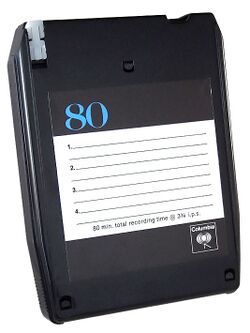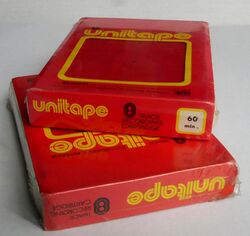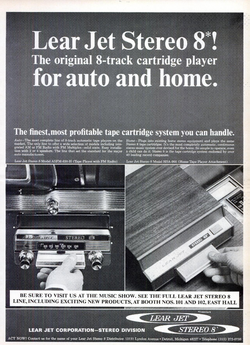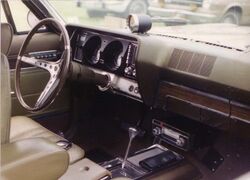8-track tape
 The inside of a cartridge. The black rubber pinch roller is at upper right. | |
| Media type | Magnetic cartridge tape endless loop |
|---|---|
| Encoding | Stereo analog signal |
| Capacity | Four stereo channels |
| Read mechanism | Tape head |
| Write mechanism | Magnetic recording head |
| Developed by | Lear Industries |
| Usage | Audio storage |
| Extended from | Fidelipac / Mohawk cartridge[1] |
The 8-track tape (formally Stereo 8; commonly called eight-track cartridge, eight-track tape, and eight-track) is a magnetic-tape sound recording technology that was popular[2] from the mid-1960s to the early 1980s, when the compact cassette, which pre-dated the 8-track system, surpassed it in popularity for pre-recorded music.[3][4][5]
The format was commonly used in cars and was most popular in the United States, the United Kingdom, Canada, New Zealand, Australia, Mexico, Spain, France, Germany, Italy, Sweden and Japan.[3][4][6] One advantage of the 8-track tape cartridge was that it could play continuously in an endless loop, and did not have to be "flipped over" to play the entire tape. After about 80 minutes of playing time, the tape would start again at the beginning. Because of the loop, there is no rewind. The only options the consumer has are play, fast forward, record, and program (track) change.[7]
The Stereo 8 Cartridge was created in 1964 by a consortium led by Bill Lear, of Lear Jet Corporation,[8] along with Ampex, Ford Motor Company, General Motors, Motorola, and RCA Victor Records (RCA - Radio Corporation of America).
The 8-track tape format is now considered obsolete, although there are collectors that refurbish these tapes and players as well as some bands that issue these tapes as a novelty. Cheap Trick's The Latest in 2009 was issued on 8-track, as was Dolly Parton's A Holly Dolly Christmas in 2020, the latter with an exclusive bonus track. Little Lost Girl Media from Oregon is currently still making 8-tracks and runs a mostly 8-track rock-n-roll record label.
Technology
The cartridge's dimensions are approximately 5.25 by 4 by 0.8 inches (13.3 cm × 10.2 cm × 2.0 cm). The magnetic tape is played at 3–3/4 inches per second (twice the speed of a cassette), is wound around a single spool, is about 0.25 inches (0.64 cm) wide and contains 8 parallel tracks. The player's head reads two of these tracks at a time, for stereo sound. After completing a program, the head mechanically switches to another set of two tracks, creating a characteristic clicking noise.[9]
History
Development
Inventor George Eash invented a design in 1953, called the Fidelipac cartridge, also called the NAB cartridge.[10]
Stereo 8
The Lear Jet Stereo 8 cartridge was designed by Richard Kraus while working for the Lear Jet Corporation, under Bill Lear, in 1963. The major change was to incorporate a neoprene rubber and nylon pinch roller into the cartridge itself, rather than to make the pinch roller a part of the tape player, reducing mechanical complexity. Lear also eliminated some of the internal parts of the Eash cartridge, such as the tape-tensioning mechanism and an interlock that prevented tape slippage. Because the Stereo-Pak cartridges were prone to jamming due to their complex design, Lear endeavored to redesign them, putting twice the number of tracks on them, doubling their recording time to 80 minutes.[11]
Commercial success

The popularity of both four-track and eight-track cartridges grew from the booming automobile industry.[12] In September 1965, the Ford Motor Company introduced factory-installed and dealer-installed eight-track tape players as an option on three of its 1966 models (the sporty Mustang, luxurious Thunderbird, and high-end Lincoln),[13] and RCA Victor introduced 175 Stereo-8 Cartridges from its RCA Victor and RCA Camden labels of recording artists catalogs.[14] By the 1967 model year, all of Ford's vehicles offered this tape player upgrade option. Most of the initial factory installations were separate players from the radio (such as shown in the image), but dashboard mounted 8-track units were offered in combination with an AM radio, as well as with AM/FM receivers.[15]
The 8-track format gained steadily in popularity because of its convenience and portability. Home players were introduced in 1966 that allowed consumers to share tapes between their homes and portable systems. By the late 1960s, the 8-track segment was the largest in the consumer electronics market and the popularity of 8-track systems for cars helped generate demand for home units.[16][page needed] "Boombox" type portable players were also popular but eight-track player/recorders failed to gain wide popularity and few manufacturers offered them except for manufacturer Tandy Corporation (for its Radio Shack electronics stores). With the availability of cartridge systems for the home, consumers started thinking of eight-tracks as a viable alternative to 33 rpm album style vinyl records, not only as a convenience for the car. Also by the late 1960s, prerecorded releases on the 8-track tape format began to arrive within a month of the vinyl release. The 8-track format became by far the most popular and offered the largest music library of all the tape systems.[17]
Early karaoke machines
Daisuke Inoue invented the first karaoke machine in 1971 called the Juke-8.[18][19]
Other use
Milton Bradley's (MB) OMNI Entertainment System was an electronic quiz machine game first released in 1980, similar to Jeopardy! or later entries in the You Don't Know Jack video game series, using 8-track tapes for questions, instructions, and answers, using audio playback as well as digital signals in magnetic-tape data storage on remaining tracks to load the right answer for counting the score. In 1978, the Mego Corporation launched the 2-XL toy robot, which utilized the tracks for determining right from wrong answers.[20] In 1977, the Scottish company GR International released the Bandmaster Powerhouse, a drum machine that played back custom-made 8-track cartridges containing drum and percussion rhythm loops recorded with real instruments. These could be subjected to a degree of processing using the drum machine's controls, which included tempo and instrument balance.[21]
Decline
1978 was the peak year for 8-track sales in the United States, with sales declining rapidly from then on.[22] Eight-track players became less common in homes and vehicles in the late 1970s. The compact cassette had arrived in 1963.[23]
In the U.S., eight-track cartridges were phased out of retail stores in late 1982 and early 1983. However, some titles were still available as eight-track tapes through Columbia House and RCA (BMG) Music Service Record Clubs until late 1988. Until 1990, Radio Shack (Tandy Corporation) continued to sell blank eight-track cartridges and players for home recording use under its Realistic brand.[24]
See also
References
- ↑ TelePro Cartridge Patent Fails, Billboard vol. 79, No. 27, 8 July 1967 p. 3
- ↑ "What Are 8-Track Tapes?". wisegeek.com. http://www.wisegeek.com/what-are-8-track-tapes.htm. "While immensely popular in the United States for a period of time ..."
- ↑ 3.0 3.1 "Collector's Corner: The History of the Eight-Track Tape". 23 December 2005. http://www.goldminemag.com/collector-resources/collectors-corner-the-history-of-the-eight-track-tape. "Just as the signs were all pointing to eight-track toppling vinyl as the format of choice for music lovers in the United States, Canada and to a lesser extent, in Great Britain, along came the audio cassette"
- ↑ 4.0 4.1 "What Are 8-Track Tapes?". http://www.wisegeek.com/what-are-8-track-tapes.htm. "Outside of the United Kingdom, Canada, and a few other nations, the use of 8-track technology was virtually unknown."
- ↑ "Eight-Track Tapes | Encyclopedia.com". https://www.encyclopedia.com/history/culture-magazines/eight-track-tapes#:~:text=The%20eight-track%20tape%20was,into%20eight%20channels,%20or%20tracks..
- ↑ "8-Tracking Around the World". http://www.8trackheaven.com/archive/world.html.
- ↑ "Car Cartridges Come Home", pp.18-22, HiFi / Stereo Review's Tape Recorder Annual 1968, retrieved May 22, 2023. (Detailed comparative diagrams of a Fidelipac cartridge on p.20, with comparison to Lear Jet 8-track cartridge and Phillips cassette diagrams on p.21.)
- ↑ Wilford, John Noble (1971-04-04). "Bill Lear Thinks He'll Have the Last Laugh" (in en-US). The New York Times. ISSN 0362-4331. Archived from the original on September 30, 2017. https://web.archive.org/web/20170929232032/https://www.nytimes.com/1971/04/04/archives/bill-lear-thinks-hell-have-the-last-laugh.html.
- ↑ "The 8-Track FAQ" (in en-US). https://8trackheaven.com/the-big-questions/8-track-faq/.
- ↑ "George Eash CARtridge inventor tells how it was born". Billboard 78 (10). 3 March 1966. https://books.google.com/books?id=BikEAAAAMBAJ&q=George+Eash+CARtridge+inventor+tells+how+it+was+born&pg=RA1-PA19. Retrieved 26 January 2013.
- ↑ Crews, Andrew D. (1 December 2003). "From Poulsen to Plastic: A Survey of Recordable Magnetic Media". https://www.ischool.utexas.edu/~cochinea/html-paper/a-crews-03-magnetic-media.html.
- ↑ "Vintage Audio Recording History". Videointerchange.com. 10 May 2012. http://www.videointerchange.com/audio_history.htm.
- ↑ Despagni, Anthony J. (1976). "Some Help From Debussy For the Hassled Driver" (in en-US). The New York Times. ISSN 0362-4331. https://www.nytimes.com/1976/01/25/archives/some-help-from-debussy-for-the-hassled-driver.html.
- ↑ "RCA Fires 175-Title Burst with Release of Stereo 8 Cartridges". Billboard 77 (39): 3. 25 September 1965. ISSN 0006-2510. https://books.google.com/books?id=HCkEAAAAMBAJ&pg=PA3. Retrieved 27 January 2013.
- ↑ Mitchell, Larry G. (2000). AMC Muscle Cars. MBI Publishing. p. 73. ISBN 978-0-7603-0761-8. https://books.google.com/books?id=JHVaQFDrx_MC&q=AMC+AM/8-track+stereo+tape+player&pg=RA1-PT16. Retrieved 26 January 2013.
- ↑ Kussisto, Oscar P. (2 November 1968). "8-track market booms". Billboard. https://books.google.com/books?id=sgoEAAAAMBAJ&q=8-track+segment+of+this+booming+market+is+by+far+the+largest&pg=RA1-PA32. Retrieved 23 April 2014.
- ↑ Shatavsky, Sam (February 1969). "The best tape system for you". Popular Science 194 (2): 126–129. https://books.google.com/books?id=5ikDAAAAMBAJ&q=Eight-track+by+far+the+most+popular+offers+the+largest+music+library&pg=PA128.
- ↑ Raftery, Brian (2008). Don't Stop Believin': How Karaoke Conquered the World and Changed My Life. Boston, Massachusetts: Da Capo Press. ISBN 978-0306815836. https://archive.org/details/dontstopbelievin00raft.
- ↑ Mitsui, Tōru; Hosokawa, Shūhei (1998). Karaoke around the world: global technology, local singing. London ; New York: Routledge. pp. 29–42. ISBN 9781280140877.
- ↑ Techmoan: MB OMNI Entertainment System - The 1980s 8-Track games machine, YouTube, 6 August 2017
- ↑ "GR International Bandmaster Powerhouse | Vintage Synth Explorer". https://www.vintagesynth.com/grinternational/bandmaster-powerhouse/.
- ↑ "U.S. Sales Database". https://www.riaa.com/u-s-sales-database/.
- ↑ "The History of the Audio Cassette". https://southtree.com/blogs/artifact/the-convenience-of-the-cassette.
- ↑ "1990 Radio Shack Catalog". http://www.radioshackcatalogs.com/catalogs/1990/.
External links
- "A Survey of Recordable Magnetic Media" by Andrew D. Crews, December, 2003, University of Texas, accessed 8 August 2006
- So Wrong They're Right - A 1995 documentary about 8-track enthusiasts
- 8-Track Heaven
- 8-Track Moments Listen to the sound of the 8-Track click
- Bill Lear Invents the 8-Track and Brings in Ford, Motorola, and RCA Victor. Recording History.org





